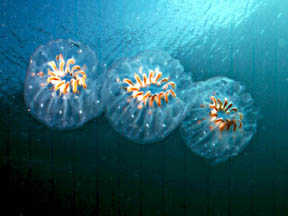Planktonic Tunicates
|
Although
the tunicates that we will discuss in class are members of the Class
Ascidiacea, which are all sessile as adults, planktonic species are important in marine food webs. Dense tunicate swarms, hundreds of kilometers
wide and many meters deep, are common in the open ocean. Swarms of larvaceans
(Class:Larvacea) may contain up to 25,000
animals per cubic meter. Larvaceans
filter organisms as small as bacteria (0.1 mm
in diameter), and in turn, are fed on by other plankton feeders, such
as sardines and herring. (The
name Larvacea is derived from the fact that they resemble the larval
stages of other tunicates). |

|
Thaliacean (Class:Thaliacea) tunicates
also occur in large, dense swarms in the open ocean. Most are aggregations of solitary individuals;
however, some form spectacular luminescent colonies. Colonies 10 m long and 1 m in diameter are common.
Individuals are oriented with oral siphons pointed outward and atrial
siphons directed toward the center of the colony.
Ciliary currents and contraction of body-wall
muscles direct water toward a central cavity of the colony and slowly move
the entire colony through the water. When
chemical or mechanical stimuli stimulate a part of the colony, the part luminesces and ceases ciliary beating.
The luminescence spread over the entire colony, and the colony stops
moving. This behavior may help the
colony avoid unfavorable environments or may confuse or frighten predators.